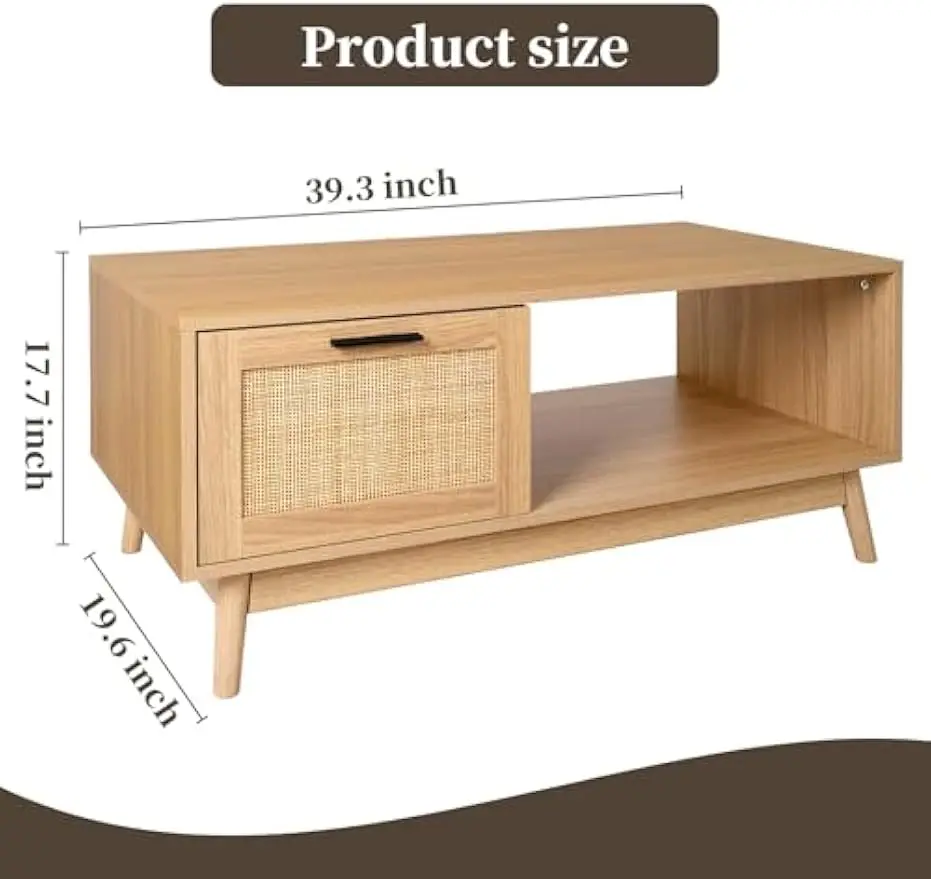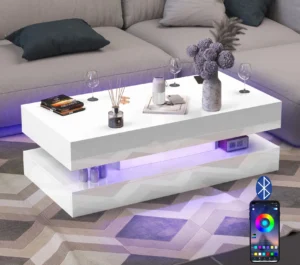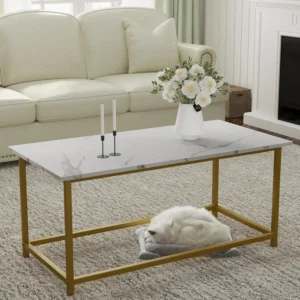Introduction: The Enduring Allure of Large Mid-Century Coffee Tables
Mid-century modern coffee tables stand as distinctive pieces that blend sleek, clean lines with organic shapes and natural materials. Born from the design revolution of the mid-20th century, these tables embrace functionality while delivering undeniable visual appeal. The larger versions of these iconic tables have maintained their popularity for good reason—they’re not just furniture pieces but statements that transform living spaces.
What makes these tables so persistently sought-after in today’s homes? The answer lies in their remarkable ability to combine visual impact with everyday practicality. Unlike many trendy furniture pieces that quickly feel dated, large mid-century coffee tables offer a timeless aesthetic that continues to complement evolving interior styles. Their generous proportions create visual anchors in living spaces while providing substantial utility that smaller tables simply cannot match.
These distinctive tables represent more than just a surface for coffee mugs—they embody an entire design philosophy that valued honesty in materials, clarity of purpose, and accessibility. The work of iconic designers like Noguchi and Nelson continues to influence contemporary furniture, with many mid-century modern large coffee tables becoming more coveted with each passing decade. When you invest in one of these pieces, you’re not just buying furniture—you’re bringing home a design statement that’s both practical investment and artistic expression.
Understanding Mid-Century Modern Design Elements
Mid-century modern design emerged as a response to changing lifestyles and new manufacturing capabilities. At its core, this aesthetic embraces several key principles that make it immediately recognizable:
- Clean geometric lines balanced with organic curves: The juxtaposition of straight edges with gentle, nature-inspired shapes creates visual interest without complexity
- Form follows function: Every element serves a purpose—there are no purely decorative components
- Minimal ornamentation: The beauty comes from proportions, materials, and craftsmanship rather than added embellishment
- Honest materials: Woods, metals, and glass are celebrated for their inherent qualities rather than disguised
In coffee table design, these principles appear as low-profile silhouettes with distinctive shapes—kidney-shaped surfaces, rectangular tops with rounded corners, or circular designs with sculptural bases. The materials typically include warm woods like walnut, teak, and rosewood, chosen specifically for their rich grain patterns and durability.
What makes these design elements so significant is how they work together to create pieces that feel both substantial and visually light. The signature tapered legs elevate tables off the floor, creating a sense of space beneath. Cantilevered or asymmetrical elements add visual intrigue while maintaining functional surfaces.
The features of large mid-century modern tables don’t just create aesthetic appeal—they solve practical problems. Their low height complements the lower-profile seating common to mid-century living rooms. Their clean lines make them easy to navigate around, and their emphasis on quality materials ensures they stand up to daily use for decades.
The Visual Anchor: How Large Coffee Tables Command Space
The substantial presence of a large mid-century coffee table transforms it from mere furniture into what designers call a “visual anchor”—a piece that grounds and defines the entire seating arrangement around it. This anchoring effect proves especially valuable in contemporary open floor plans where spaces need definition without walls.
What makes these tables particularly effective as anchors is their masterful balance of visual weight and lightness. While their surface area commands attention, their characteristic elevated stance on slender legs prevents them from appearing heavy or cumbersome. This creates a fascinating contradiction—they’re simultaneously substantial and airy.
In proper proportion, a large coffee table should measure approximately two-thirds the length of your sofa, creating a harmonious visual relationship between the pieces. The typical low profile of mid-century designs (usually 16-18 inches high) maintains open sight lines across a room while providing a comfortable height for use while seated.
Expertly arranging a room around a large coffee table involves creating conversation zones where seating naturally frames the table. The table then serves as both functional surface and visual centerpiece, drawing the eye and establishing the room’s center of gravity. This arrangement works particularly well with rectangular coffee tables, which mirror the linear shape of most sofas while maximizing usable surface area.
When properly positioned, these tables don’t just fill space—they define it, transforming disconnected furniture pieces into a cohesive seating arrangement that feels intentional and inviting.
Material Advantages: Natural Beauty Meets Durability
The materials chosen for mid-century coffee tables weren’t selected merely for their appearance—they were chosen for their longevity, character, and functionality. This thoughtful material selection contributes significantly to their enduring appeal.
Hardwoods
The solid hardwoods predominant in mid-century design deliver multiple advantages. Woods like walnut, teak, and rosewood provide:
- Structural integrity that maintains stability over decades of use
- Natural warmth that softens the geometric lines of the designs
- Character through distinctive grain patterns that become more beautiful with age
- Ability to be repaired and refinished, extending lifespan indefinitely
On larger tables, these qualities become even more apparent. The expanded surface area showcases the natural grain patterns dramatically, turning the woodwork into a focal point rather than simply a structural element. The patina that develops on these woods over time adds character that manufactured materials cannot replicate.
Glass
Glass elements, often used for table tops or inset sections, contribute their own advantages:
- Visual lightness that counterbalances wooden components
- Reflective qualities that enhance room lighting
- Transparency that showcases structural elements beneath
- Durability against staining and easy maintenance
Metals
Metallic elements, typically brass, steel or aluminum, provide:
- Structural support without visual heaviness
- Contrasting texture against wood and glass
- Distinctive detailing through hardware and trim
- Corrosion resistance for long-term durability
The solid wood coffee tables in mid-century design frequently combine these materials for both aesthetic and functional reasons. A wooden frame might support a glass top, while metal legs provide stable support with minimal visual mass. This material combination allows these substantial pieces to maintain an impression of lightness despite their size.
Functional Advantages: Surface Area and Versatility
Beyond their aesthetic contributions, the generous dimensions of large mid-century coffee tables deliver practical benefits that smaller tables simply cannot match. Their expanded surface area transforms them into multi-purpose pieces that adapt to various needs throughout the day.
For entertaining, these tables excel by providing ample space for:
– Serving trays with drinks and appetizers
– Multiple table settings when casual dining is desired
– Board games and card games with comfortable reach for all players
– Displaying large format books or collections
In daily use, the expanded surface allows for:
– Simultaneous use by multiple family members
– Temporary workspace for laptops or projects
– Displaying decorative objects without cluttering the surface
– Layering items at different heights for visual interest
Many designs incorporate thoughtful storage features without sacrificing the clean aesthetic. Hidden drawers tuck away remote controls and small items, while lower shelves provide accessible storage for magazines, books, or throws. The careful proportions ensure that these functional elements enhance rather than detract from the visual appeal.
The versatile appeal of large mid-century coffee tables stems from this blend of generous surface area and intelligent design. Unlike purely decorative pieces, these tables earn their prominent position in the living space through daily usefulness.
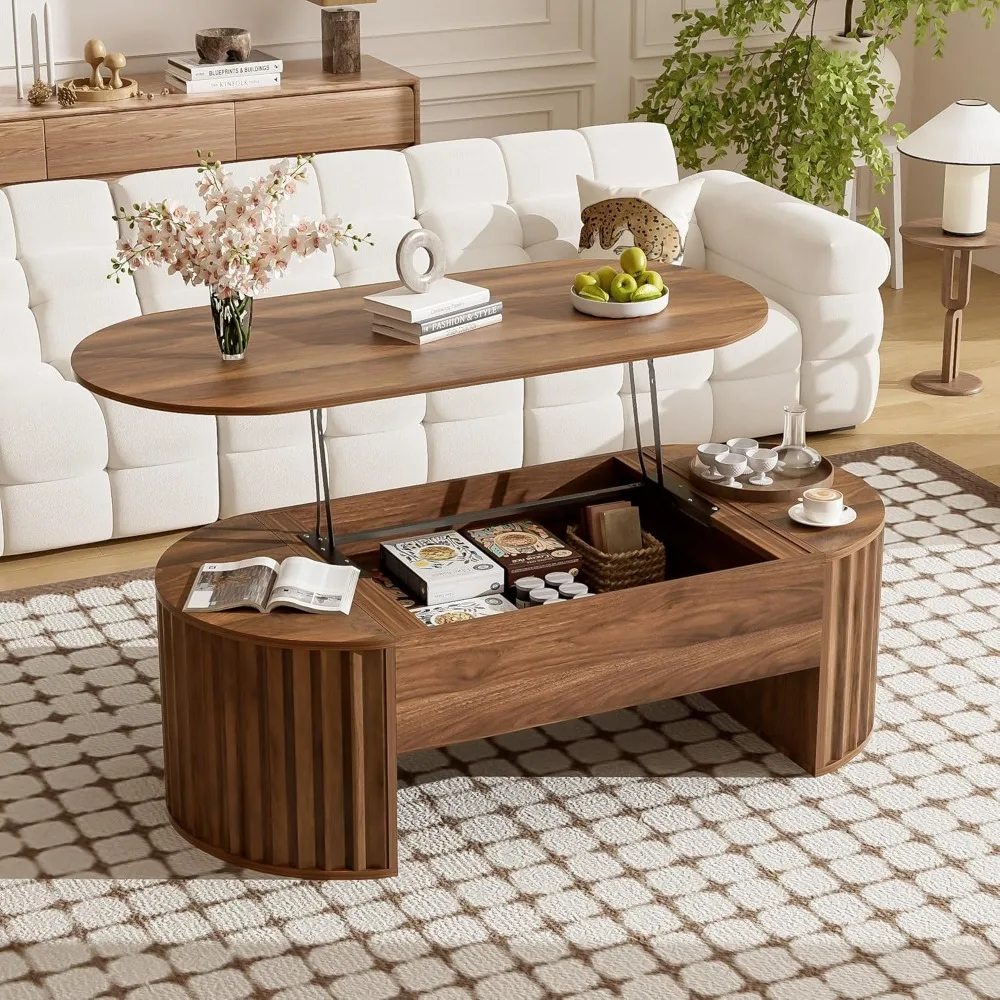
Shape Matters: Choosing the Right Large Mid-Century Table
The shape of your coffee table significantly impacts both its function and how it relates to your space. Each shape offers distinct advantages worth considering.
Rectangular Tables
The most common shape provides:
– Maximum usable surface area
– Clear delineation of the seating area
– Proportional balance with standard sofas
– Efficient use of space in rectangular rooms
Rectangular tables work particularly well in traditional seating arrangements with a sofa and chairs opposite each other. Their linear form creates natural pathways around the seating area.
Square Tables
Perfect for balanced arrangements, square tables offer:
– Equal access from all sides
– Strong geometric presence
– Ideal coordination with sectional sofas or four-chair groupings
– Versatility for games and activities requiring equal reach
Oval and Round Tables
These softer shapes provide:
– Safer environments for homes with small children (no sharp corners)
– Improved traffic flow with their curved perimeters
– Ability to accommodate more people in tight spaces
– Visually softer presence that balances angular furniture
The comparison between rectangular and round tables often comes down to room layout and personal preference. Rectangular pieces maximize surface area, while round tables facilitate conversation with their democratic shape that puts everyone at equal distance.
Free-form or organic shapes represent the most artistic expressions of mid-century design. These distinctive tables become conversation pieces and focal points, often incorporating asymmetry or biomorphic shapes inspired by nature.
When selecting between shapes, consider both your practical needs and how the table will guide movement through your space. The benefits of round mid-century tables might be perfect for encouraging interaction in a family room, while a rectangular piece might better serve a formal living area.
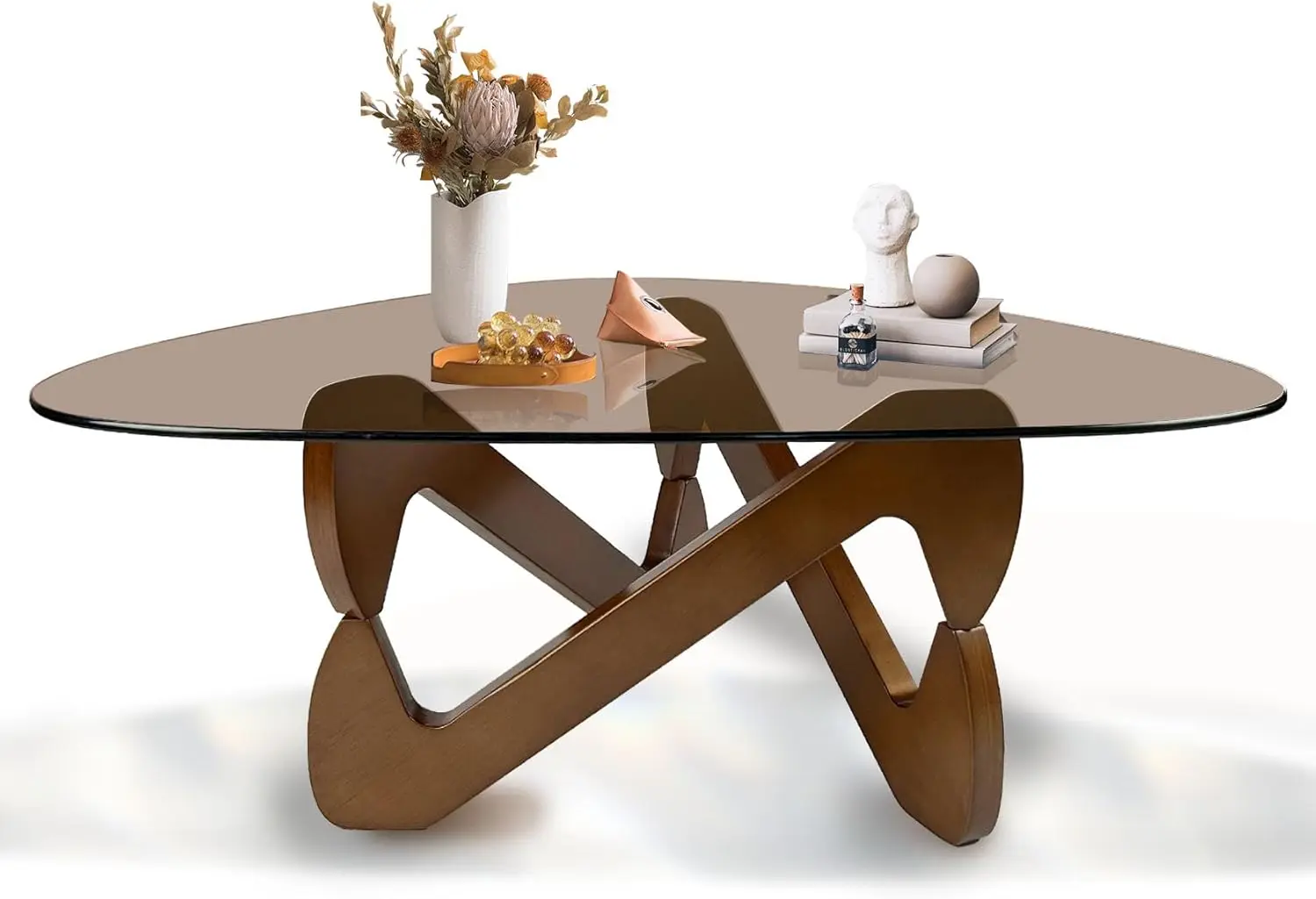
Storage Solutions: The Hidden Advantage of Mid-Century Design
While the clean lines and uncluttered appearance of mid-century design might suggest simplicity, many large coffee tables from this era incorporate ingenious storage features that enhance their functionality without compromising aesthetics.
The mid-century philosophy of “form follows function” is perfectly exemplified in these storage solutions. Rather than adding storage as an afterthought, designers integrated it seamlessly into the overall concept:
- Open shelving beneath the main surface provides accessible storage for books and magazines while maintaining visual lightness
- Hidden drawers with flush fronts preserve clean lines while offering convenient storage for remote controls, coasters, and small items
- Magazine racks integrated into side panels add functionality without disrupting the silhouette
- Compartmentalized storage sections organize different items while creating visual interest
These storage elements follow the same design principles as the tables themselves—clean lines, quality materials, and meticulous craftsmanship. Drawer pulls might be minimal indentations rather than protruding hardware, and shelves often feature the same attention to detail as the main surface.
The expanded dimensions of larger tables allow for more substantial storage solutions without compromising the overall design integrity. This makes lift-top coffee tables particularly valuable in smaller living spaces where every square inch must serve multiple purposes.
The intelligent integration of storage represents one of the most practical yet underappreciated advantages of mid-century design—solving everyday problems with elegant solutions rather than obvious utility.
Styling Versatility: Integration Across Design Aesthetics
One remarkable quality of large mid-century coffee tables is their chameleon-like ability to complement various interior styles. Their clean lines and emphasis on natural materials allow them to transition seamlessly between different design contexts.
In pure mid-century rooms, these tables serve as anchoring elements that reinforce the overall aesthetic. Paired with other period pieces, they create cohesive, harmonious spaces that celebrate the design principles of the era.
However, these tables truly shine in their ability to integrate into diverse styling approaches:
In contemporary minimalist spaces, their warm materials add necessary texture and organic elements to spaces that might otherwise feel sterile. Their clean lines complement minimalist aesthetics while their natural materials add welcome warmth.
Within eclectic or maximalist interiors, these tables provide a stabilizing presence—their clear forms and honest materials offering visual rest amidst more ornate or colorful elements. The substantial presence of a large mid-century piece creates a focal point that helps organize more diverse surrounding elements.
Even in traditional settings, these tables can introduce a modern touch without creating jarring contrast. Their emphasis on craftsmanship and natural materials finds common ground with traditional furniture, while their clean forms gently update the overall feel.
This versatility stems from the fundamental qualities that define mid-century design—honest materials, functional forms, and timeless proportions. By mastering the use of statement piece coffee tables in your design scheme, you can create a focal point that anchors your space while allowing other elements to evolve around it.
The Investment Perspective: Longevity and Lasting Appeal
Beyond their aesthetic and functional advantages, large mid-century coffee tables often represent sound long-term investments. Several factors contribute to their enduring value:
Quality construction methods stand at the heart of authentic mid-century pieces. Traditional joinery techniques like dovetail and mortise-and-tenon connections create structural integrity that survives decades of use. Unlike mass-produced contemporaries built with hidden fasteners and engineered materials, these techniques result in furniture that can be repaired rather than replaced when damaged.
The materials themselves improve with age. Solid hardwoods develop rich patinas that enhance their character over time. Quality metals develop distinctive oxidation patterns that collectors prize. Even the wear patterns that develop through use tell a story of utility and appreciation.
From a sustainability perspective, investing in quality, long-lasting furniture represents responsible consumption. A well-made coffee table might serve several generations of users, keeping materials out of landfills while reducing the environmental impact of manufacturing replacement pieces.
The timeless design qualities that define these pieces—clean lines, honest materials, and functional proportions—have transcended trends for decades. Unlike furniture styles that clearly mark themselves as products of a specific decade, the best mid-century designs possess a timelessness that allows them to feel perpetually contemporary.
This combination of quality construction, durable materials, and enduring design makes vintage coffee tables particularly valuable. Whether original vintage pieces or faithful contemporary reproductions built to the same standards, these tables offer lasting value that transcends their initial cost.
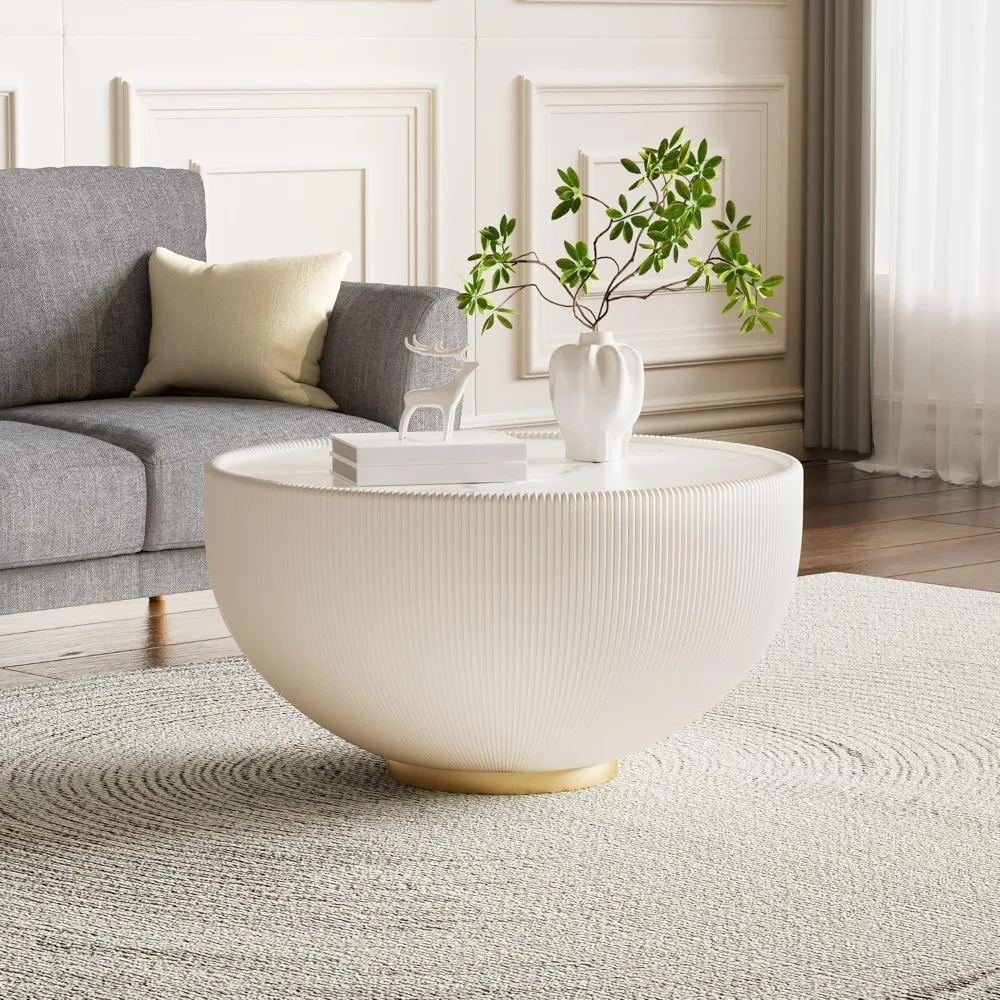
Practical Considerations: Finding Your Perfect Match
Selecting the ideal large mid-century coffee table requires balancing aesthetic preferences with practical considerations. Here’s how to ensure your choice works beautifully in your space:
Room Size and Clearance
Allow 14-18 inches between the coffee table edge and surrounding seating—enough space for comfortable leg room while keeping the table within easy reach. Ensure walkways around the furniture arrangement maintain at least 24-30 inches for comfortable traffic flow.
Proportional Balance
Your coffee table should typically measure about two-thirds the length of your primary sofa to maintain visual balance. The height should be within 1-2 inches of your seating cushions for comfortable use while seated.
Material Selection for Lifestyle
Consider how your table will be used:
– Households with children might prefer rounded corners and durable surfaces
– Homes where dining happens at the coffee table benefit from easy-clean materials
– Spaces with heavy use should prioritize solid wood over veneers for longevity
Statement vs. Function
Determine whether you need your table to be primarily:
– A dramatic design statement with distinctive shape or materials
– A functional workhorse with ample surface and storage
– A balanced combination of both qualities
Authentic vs. Reproduction
When choosing between vintage pieces and contemporary reproductions, consider:
– Budget constraints (authentic vintage pieces often command premium prices)
– Condition concerns (vintage pieces may have existing wear)
– Size requirements (contemporary reproductions often offer more size options)
Mastering space planning with oversized coffee tables involves careful measurement and thoughtful arrangement of surrounding furniture. Take time to mark out the proposed footprint with painter’s tape before purchasing to visualize how the piece will impact movement through your space.
Mid-Century Modern Solid Wood Coffee Tables, Mid-Century Modern Teak Coffee Tables
$879.95 Select options This product has multiple variants. The options may be chosen on the product pageMid-Century Modern Danish Coffee Tables, Mid-Century Modern Oval Coffee Tables, Mid-Century Modern Solid Wood Coffee Tables
$390.05 Select options This product has multiple variants. The options may be chosen on the product pageMid-Century Modern Glass Top Coffee Tables, Mid-Century Modern Vintage Coffee Tables, Mid-Century Modern Vintage Side & End Tables
$725.36 Select options This product has multiple variants. The options may be chosen on the product pageMid-Century Modern Lift Top Coffee Tables, Mid-Century Modern Square Coffee Tables
$454.73 Select options This product has multiple variants. The options may be chosen on the product pageMid-Century Modern Large Coffee Tables, Mid-Century Modern Rectangular Coffee Tables
$603.26 Select options This product has multiple variants. The options may be chosen on the product pageMid-Century Modern Marble Top Coffee Tables, Mid-Century Modern Rectangular Coffee Tables, Mid-Century Modern White Coffee Tables
Price range: $163.28 through $189.22 Select options This product has multiple variants. The options may be chosen on the product page
Remember that the perfect coffee table balances visual appeal with practical function—the hallmark of truly successful mid-century design lies in this harmonious combination.
Are Large Mid-Century Coffee Tables Suitable for Small Spaces?
While it might seem counterintuitive, larger coffee tables can actually work beautifully in smaller spaces when chosen thoughtfully. Several mid-century design characteristics make this possible:
The elevated stance on slender legs creates visual space beneath the table, maintaining an open feel even with a substantial surface area. This “floating” quality allows small rooms to breathe visually despite the larger footprint.
Glass tops or inserts further reduce visual weight, allowing light to pass through and creating the impression of more space. The transparency maintains sightlines across the room, preventing the closed-in feeling that can come with solid, heavy pieces.
Low profiles keep these tables from interrupting sight lines across the room. A table that sits lower than the arm height of surrounding seating maintains an open feel throughout the space.
For truly limited spaces, consider these adaptations:
– Choose oval or round shapes that eliminate sharp corners from traffic paths
– Select pieces with integrated storage to reduce the need for additional furniture
– Look for nesting table sets that can expand when needed and contract when space is at a premium
With careful selection, a larger coffee table can actually simplify a small space by eliminating the need for multiple smaller tables while providing a strong central focus.
How Do Mid-Century Coffee Tables Compare to Other Popular Styles?
Understanding how mid-century coffee tables differ from other popular styles helps clarify their unique advantages:
Compared to industrial-style tables, mid-century pieces emphasize warmth and organic shapes rather than raw materials and utilitarian construction. While both styles celebrate honest materials, mid-century designs refine them into more elegant, residential-appropriate forms. The visual weight differs significantly—industrial pieces often appear deliberately heavy and substantial, while mid-century designs aim for visual lightness despite their size.
Contemporary tables share mid-century’s clean lines but often employ more manufactured materials like engineered woods or plastics. Mid-century’s emphasis on natural materials with visible grain patterns creates a warmth that many contemporary pieces lack. The craftsmanship approach also differs—mid-century design values visible evidence of handwork, while contemporary pieces often aim for machine-perfect precision.
Traditional coffee tables typically feature more ornate detailing, darker finishes, and heavier proportions. Mid-century pieces strip away this ornamentation in favor of letting materials and proportions speak for themselves. This makes mid-century tables more adaptable to changing decor around them, while traditional pieces often require complementary traditional elements to look appropriate.
Rustic tables celebrate imperfections and natural irregularities, while mid-century design controls these elements into more refined expressions. Both styles value natural materials, but mid-century approaches impose geometric discipline that rustic pieces intentionally avoid.
This distinctive balance of qualities—refined but warm, substantial but visually light, geometric but organic—creates the unique advantage that mid-century tables bring to living spaces.
How to Care for Your Large Mid-Century Coffee Table
Preserving the beauty and functionality of your mid-century coffee table requires appropriate care tailored to its materials:
For wood surfaces, dust regularly with a soft, slightly damp cloth, following the direction of the grain. Apply high-quality furniture wax or oil (appropriate to your specific wood type) every 6-12 months to maintain luster and protect the surface. Avoid placing extremely hot items directly on wood—use trivets or coasters to prevent heat damage.
For glass elements, clean with a quality glass cleaner and lint-free cloth. Spray the cloth rather than the surface directly to prevent liquid from seeping into seams where glass meets other materials. Buff with a dry microfiber cloth for a streak-free finish.
For metal components, dust regularly and occasionally polish with appropriate metal cleaner. Different metals require different care—brass may need specific polish, while stainless steel typically needs just a damp cloth.
Prevent damage by using coasters under beverages, placemats under dishes, and felt pads under any decorative objects that might scratch the surface. Position your table away from direct sunlight, which can fade wood finishes unevenly over time.
For vintage pieces showing wear, consult with furniture restoration specialists rather than attempting major repairs yourself. Quality mid-century pieces often respond well to professional restoration, allowing them to maintain both beauty and value for decades to come.
With proper care, your large mid-century coffee table will continue to serve as both functional tool and design statement, potentially becoming an heirloom piece that carries both memories and beauty into the future.

